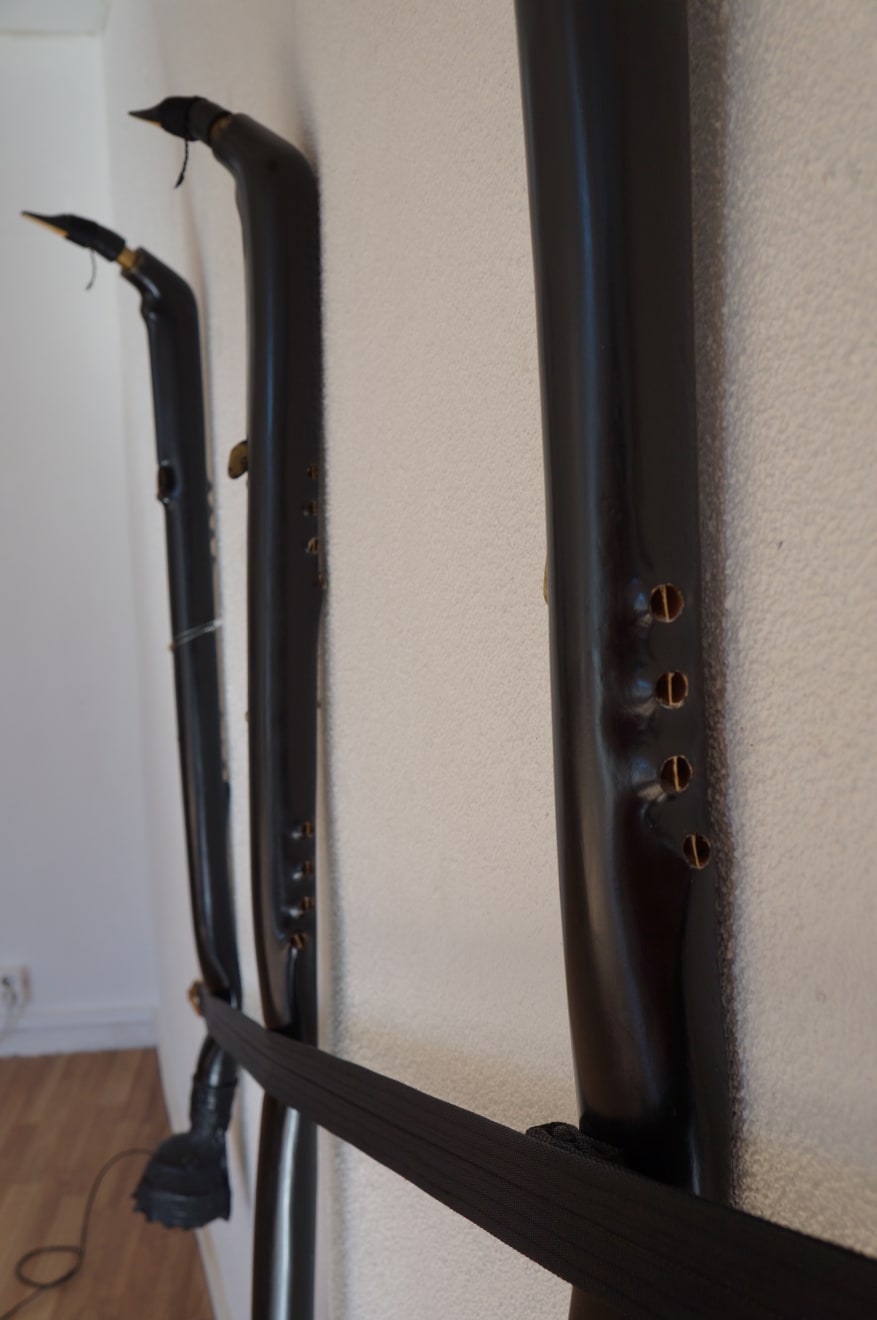Open a larger version of the following image in a popup:
 Photo Massimiliano Monnecchi
Photo Massimiliano Monnecchi
 Photo Massimiliano Monnecchi
Photo Massimiliano Monnecchi
Vytautas Viržbickas Lithuanian, b. 1987
Skamba lyg okupacija / Sounds like Occupation, 2015
4 kontrabosinės birbynės: bambukiniai liežuvėliai, beržo mediena, žalvaris, epoksidinis juodas gelkautas, emaliniai dažai, diržas, užtempimo sągtis / 4 double bass birbynės: bamboo reeds, birch wood, brass, black epoxide gelcoat, enamel paint, belt, fastening buckle
Dimensions variable
Further images
On the 14th of June 1940 the Soviet Union occupied and then on the 3rd of August same year annexed Lithuania, which it ruled until it was occupied by the...
On the 14th of June 1940 the Soviet Union occupied and then on the 3rd of August same year annexed Lithuania, which it ruled until it was occupied by the Nazi Germany in June of 1941.
Then in the summer of 1944 the Soviet Union occupied Lithuania again and ruled it until the re-establishment of its independence on the 11th of March 1990.
The beginning of a period that saw improvements of birbynės (Lithuanian aerophone instrument) coincides with the first years of Lithuania's occupation in 1940, when orchestra of folk instruments was created by "Lithuanian" ensemble. Following long experiments and tests, Povilas Samuitis and Pranas Serva constructed an improved high-pitched chromic birbynė in 1950, while Pranas Kupčikas concocted a double bass one in 1952 and a tenor chromic birbynė the following year.
The family of improved birbynės is composed of high-pitched, tenor and double bass ones. The body of high-pitched and tenor birbynės is made of ash tree, maple, apple tree and pear tree, while double bass ones are made of metal. Nowadays double bass birbynė is an instrument that is becoming extinct: it is neither being made nor used.
Four double bass birbynės are fastened by a wide black buckle belt and located as if according to unary numeral system. This tally mark is used to keep track of the score in sports and different games. Such counting systems is ideal for counting days gone by, which is why it is widely used by incarcerated people. This is how they count their days of imprisonment.
The exhibited musical instruments are not perfect copies of real double bass birbynės, since the latter are becoming extinct and there are no masters left who could pass on the production method. For instance, instead of using a cattle horn or its imitation (which would be the case in reality), an imitation of a sea shell has been used here. Both the deformed double bass birbynės as well as the sign that they compose on the wall, remind of past lives being restricted in Lithuania. It is as if they embody the period of Lithuania's occupation but also perfectly fit into today's scenario of Russia terrorizing Ukraine and occupying Crimea.
Then in the summer of 1944 the Soviet Union occupied Lithuania again and ruled it until the re-establishment of its independence on the 11th of March 1990.
The beginning of a period that saw improvements of birbynės (Lithuanian aerophone instrument) coincides with the first years of Lithuania's occupation in 1940, when orchestra of folk instruments was created by "Lithuanian" ensemble. Following long experiments and tests, Povilas Samuitis and Pranas Serva constructed an improved high-pitched chromic birbynė in 1950, while Pranas Kupčikas concocted a double bass one in 1952 and a tenor chromic birbynė the following year.
The family of improved birbynės is composed of high-pitched, tenor and double bass ones. The body of high-pitched and tenor birbynės is made of ash tree, maple, apple tree and pear tree, while double bass ones are made of metal. Nowadays double bass birbynė is an instrument that is becoming extinct: it is neither being made nor used.
Four double bass birbynės are fastened by a wide black buckle belt and located as if according to unary numeral system. This tally mark is used to keep track of the score in sports and different games. Such counting systems is ideal for counting days gone by, which is why it is widely used by incarcerated people. This is how they count their days of imprisonment.
The exhibited musical instruments are not perfect copies of real double bass birbynės, since the latter are becoming extinct and there are no masters left who could pass on the production method. For instance, instead of using a cattle horn or its imitation (which would be the case in reality), an imitation of a sea shell has been used here. Both the deformed double bass birbynės as well as the sign that they compose on the wall, remind of past lives being restricted in Lithuania. It is as if they embody the period of Lithuania's occupation but also perfectly fit into today's scenario of Russia terrorizing Ukraine and occupying Crimea.









